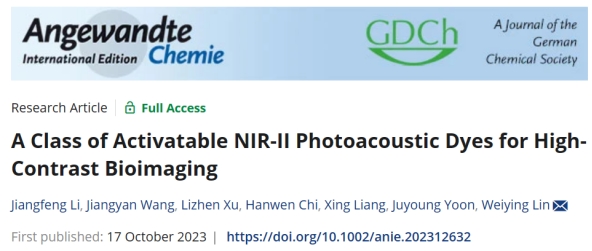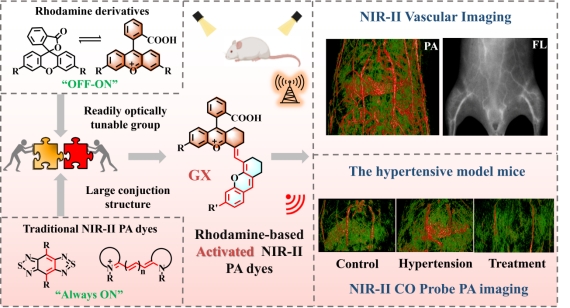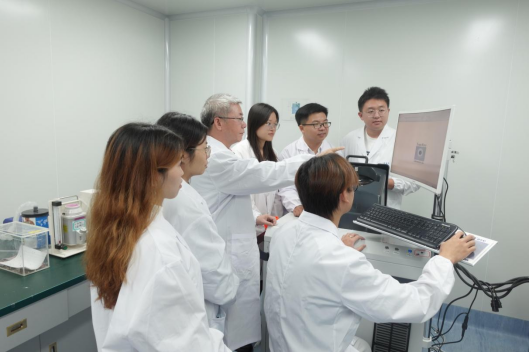Recently, the Probe and Chemical Biology Team of the School of Chemistry and Chemical Engineering of Guangxi Univeristy has made a breakthrough in NIR-II ( 900-1700 nm) optical imaging. The team constructed a series of activatable NIR-II photoacoustic dyes platform GX, publishing a paper titled “A Class of Activatable NIR-II Photoacoustic Dyes for High-Contrast Bioimaging” (DOI: 10.1002/anie.202312632) in Angewandte Chemie International Edition, which focuses on the challenge that the lack of groups that facilitate the optical tuning in NIR-II photoacoustic dyes hinders the effective application of NIR-II photoacoustic dyes in complex and diverse molecular imaging. The lead author of the paper is Li Jiangfeng, a Ph.D. candidate of the School of Chemistry and Chemical Engineering in Guangxi University, and the corresponding author is Prof. Dr. Lin Weiying, Guangxi University being the first affiliation.

Photoacoustic (PA) Imaging is becoming one of the important non-invasive imaging techniques in biomedical research. However, most of the current conventional photoacoustic dyes have wavelengths concentrated in the visible and NIR-I (700-900 nm), which have limited tissue penetration depth and spatial resolution. In contrast, photoacoustic dyes in NIR-II can provide more comprehensive and in-depth in vivo physiological and pathological information. Due to the lack of groups that facilitate the optical tuning, NIR-II photoacoustic dyes typically exhibit a “always-on” feature, which hinders their effective use in complex and diverse molecular imaging applications.
In order to solve the uncontrolled “on-off” photoacoustic signals, the team designed a novel rhodamine-based NIR-II photoacoustic dye platform GX, with the same powerful optical switching mechanism as that of traditional rhodamine dyes and the absorption and emission wavelengths of NIR-II, the absorption and emission wavelengths of the dye GX-5 reaching up to 1082 nm and 1360 nm respectively. The DFT calculations have shown that the GX dye possesses the structural features typical of rhodamine dyes, with smaller molecular orbital gaps and larger dipole moments, compared to the conventional rhodamine dyes in the visible region and the NIR-I of rhodamine dyes. To further demonstrate the excellent photoacoustic properties of dye GX, the lead author used dye GX-5 to visualize the distribution and structure of the mouse vascular system in 3D by photoacoustic imaging. In addition, using dye GX-5 as an activatable dye platform, the authors further constructed the first NIR-II probe GX-5-CO for the specific detection of carbon monoxide, which is able to reveal enhanced carbon monoxide levels in hypertensive mice by high-contrast NIR-II photoacoustic imaging, demonstrating the value of the novel NIR-II functional rhodamine-based photoacoustic dye GX. This work will not only inspire researchers to develop efficient small-molecule NIR-II dye platforms for target-activatable photoacoustic probes, but will also promote further application of NIR-II dyes in photoacoustic imaging for precise imaging to guide diseases with complex diagnoses and surgeries.

It is known that the Probe and Chemical Biology team relies on the School of Chemistry and Chemical Engineering and the Institute of Optical Functional Materials and Chemical Biology of Guangxi University. The head of the team, Prof.Dr. Lin Weiying, Fellow of the Royal Society of Chemistry, serves as the Editor of Sensors and Actuators B: Chemical. As a corresponding author, Prof.Dr. Lin Weiying has published more than 450 quality papers, including Nature Protocols, Chemical Reviews, Journal of the American Chemical Society, Angewandte Chemie International Edition, etc., whose papers have been cited more than 24,900 times.

(Prof.Dr. Lin Weiying’s Research Team)